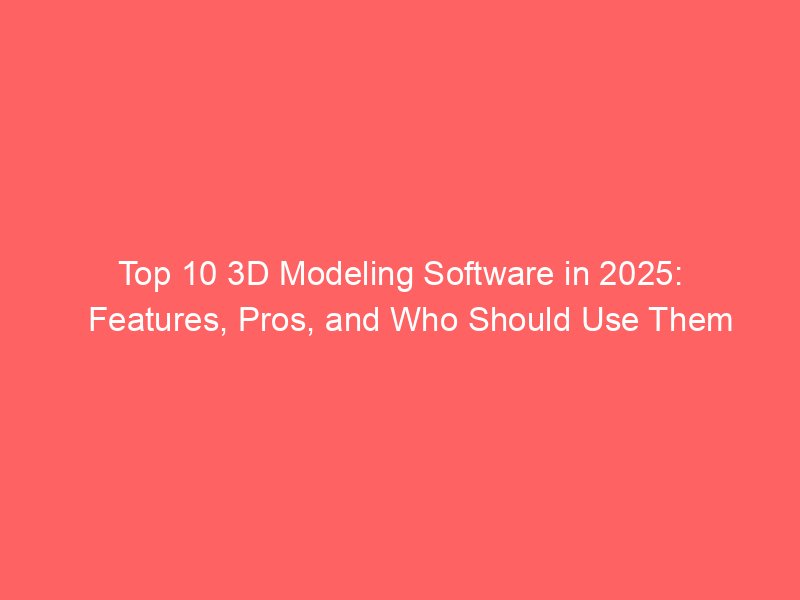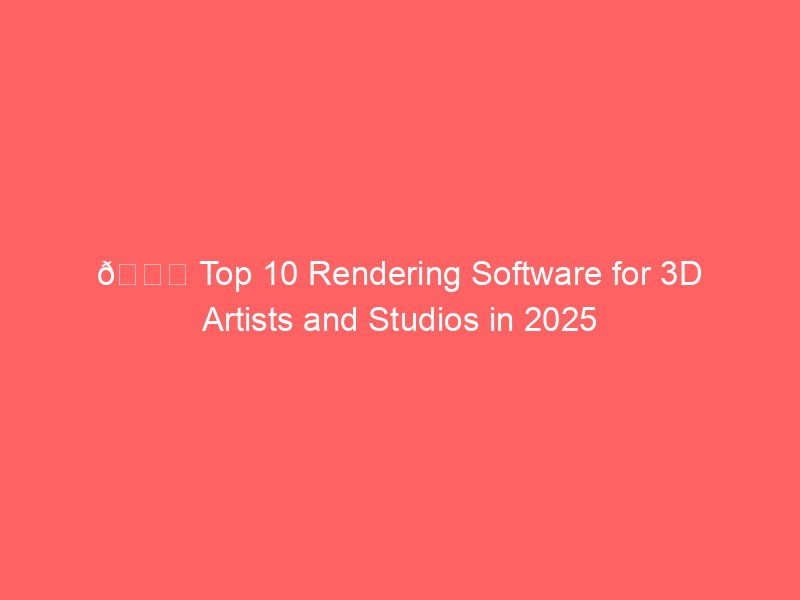3D modeling has transformed the way industries design, visualize, and create. From crafting lifelike characters in movies to designing cutting-edge products, 3D modeling software serves as the foundation for modern creativity. Whether you’re a professional architect, an animator, or a hobbyist, choosing the right 3D modeling software can make all the difference.
Below, we break down the 10 best 3D modeling software tools available today, highlighting their strengths, weaknesses, and best use cases.
1. Autodesk Maya
- Best for: Animation studios, film production, character modeling
- Overview: Maya is a flagship tool in the 3D industry, known for its high-end animation and modeling capabilities. It’s used extensively in Hollywood blockbusters and game studios.
- Features:
- Advanced character rigging and animation tools
- Robust dynamics and effects (hair, fur, fluids)
- Python and MEL scripting for automation
- Advanced character rigging and animation tools
- Pros:
- Industry standard for animation
- Huge library of plugins
- Excellent rendering engines (Arnold, V-Ray support)
- Industry standard for animation
- Cons:
- Expensive
- Steep learning curve
- Expensive
- Verdict: If you want to work in animation or visual effects professionally, Maya is the gold standard.
2. Blender
- Best for: Beginners to professionals looking for free, open-source 3D tools
- Overview: Blender has exploded in popularity over the past decade. Once considered a hobbyist tool, it’s now a professional-grade solution.
- Features:
- Full modeling, sculpting, and animation suite
- Integrated Cycles and Eevee render engines
- Grease Pencil tool for 2D/3D hybrid animation
- Full modeling, sculpting, and animation suite
- Pros:
- 100% free and open source
- Huge active community with tutorials and plugins
- Regular updates with cutting-edge features
- 100% free and open source
- Cons:
- Can be overwhelming with too many tools
- Industry adoption in studios is still lower than Autodesk
- Can be overwhelming with too many tools
- Verdict: Perfect for freelancers, indie developers, or anyone not ready to invest thousands in software.
3. Autodesk 3ds Max
- Best for: Game developers, architectural visualization
- Overview: 3ds Max is a staple in game design and architecture due to its robust modeling and rendering capabilities.
- Features:
- Powerful polygon and spline modeling tools
- Seamless integration with Arnold renderer
- Excellent motion graphics support
- Powerful polygon and spline modeling tools
- Pros:
- User-friendly compared to Maya
- Strong third-party plugin ecosystem
- Ideal for hard-surface modeling
- User-friendly compared to Maya
- Cons:
- Windows-only software
- Expensive
- Windows-only software
- Verdict: If you’re into architectural visualization or game development, 3ds Max is often preferred over Maya.
4. Cinema 4D
- Best for: Motion graphics, design professionals
- Overview: Developed by Maxon, Cinema 4D is known for its intuitive interface and integration with Adobe After Effects. It’s the go-to for motion graphics artists.
- Features:
- MoGraph module for advanced motion graphics
- GPU-accelerated rendering
- Procedural modeling tools
- MoGraph module for advanced motion graphics
- Pros:
- Easy to learn compared to Maya or Blender
- Strong for 3D design + motion graphics workflows
- Excellent stability
- Easy to learn compared to Maya or Blender
- Cons:
- Pricey subscription
- Not as advanced for character animation as Maya
- Pricey subscription
- Verdict: Best choice for designers working on motion graphics or branding projects.
5. ZBrush
- Best for: Digital sculpting, character artists
- Overview: ZBrush by Pixologic is the industry leader for sculpting lifelike characters and creatures.
- Features:
- Dynamic tessellation with Sculptris Pro
- Polypainting directly on 3D surfaces
- IMM brushes for customizable details
- Dynamic tessellation with Sculptris Pro
- Pros:
- Absolute powerhouse for sculpting
- Used in every major film/game studio
- Can handle billions of polygons
- Absolute powerhouse for sculpting
- Cons:
- Limited for hard-surface modeling
- UI can feel complex
- Limited for hard-surface modeling
- Verdict: Essential for character designers, sculptors, and concept artists.
6. SketchUp
- Best for: Architects, interior designers, construction
- Overview: SketchUp is beloved for its simplicity and efficiency in architectural modeling. It’s user-friendly and web-based options make it highly accessible.
- Features:
- Intuitive push-pull modeling
- Massive library of free 3D assets (3D Warehouse)
- VR support for architectural walkthroughs
- Intuitive push-pull modeling
- Pros:
- Extremely easy to learn
- Great free version
- Perfect for quick concept visualization
- Extremely easy to learn
- Cons:
- Limited rendering capabilities without plugins
- Not suitable for advanced animations
- Limited rendering capabilities without plugins
- Verdict: If you’re in architecture or interior design, SketchUp is unbeatable for speed and simplicity.
7. Rhinoceros 3D (Rhino)
- Best for: Product design, jewelry, CAD modeling
- Overview: Rhino is famous for its NURBS-based modeling, making it a top choice for precision design in engineering and manufacturing.
- Features:
- Advanced NURBS curve and surface modeling
- Grasshopper plugin for algorithmic design
- Wide format compatibility (CAD, CAM, 3D printing)
- Advanced NURBS curve and surface modeling
- Pros:
- Highly accurate models
- Strong for product/jewelry prototyping
- Affordable compared to Autodesk products
- Highly accurate models
- Cons:
- Not as intuitive for beginners
- Lacks advanced animation tools
- Not as intuitive for beginners
- Verdict: Best for industries where precision and manufacturing-ready models are crucial.
8. Modo
- Best for: Artists who want balance between modeling and rendering
- Overview: Developed by Foundry, Modo is known for its artist-friendly workflow and strong rendering capabilities.
- Features:
- Direct modeling and procedural modeling
- Powerful sculpting and painting tools
- Excellent rendering with built-in tools
- Direct modeling and procedural modeling
- Pros:
- Intuitive and artist-focused interface
- Strong hybrid between modeling and sculpting
- High-quality renders out-of-the-box
- Intuitive and artist-focused interface
- Cons:
- Not as widely adopted in major studios
- Fewer learning resources than Blender or Maya
- Not as widely adopted in major studios
- Verdict: A hidden gem for freelancers and smaller studios who want flexibility.
9. Houdini
- Best for: VFX, procedural modeling, simulation-heavy projects
- Overview: Houdini by SideFX is legendary for its node-based procedural workflow, making it perfect for effects like explosions, smoke, and particle systems.
- Features:
- Node-based procedural system
- Industry-leading simulation tools (fluids, fire, destruction)
- Karma and Redshift rendering support
- Node-based procedural system
- Pros:
- Best in class for visual effects
- Highly customizable with procedural workflows
- Widely used in film and gaming
- Best in class for visual effects
- Cons:
- Steep learning curve
- Expensive
- Steep learning curve
- Verdict: If you’re aiming for a VFX career in films/games, Houdini is a must-learn.
10. TinkerCAD
- Best for: Beginners, hobbyists, students, 3D printing enthusiasts
- Overview: Developed by Autodesk, TinkerCAD is a free, web-based 3D modeling tool aimed at absolute beginners.
- Features:
- Drag-and-drop modeling interface
- Direct STL export for 3D printing
- Integration with Minecraft and other learning tools
- Drag-and-drop modeling interface
- Pros:
- Completely free
- Extremely beginner-friendly
- Great for education and kids learning 3D design
- Completely free
- Cons:
- Very limited compared to pro software
- Lacks advanced rendering or animation
- Very limited compared to pro software
- Verdict: Best entry point for kids, educators, and hobbyists exploring 3D modeling for the first time.
Final Thoughts
3D modeling software isn’t one-size-fits-all. Maya, ZBrush, and Houdini dominate the film/gaming world, while SketchUp and Rhino shine in design and architecture. Meanwhile, Blender democratizes 3D modeling for everyone with its free, open-source ecosystem.
Your choice should depend on:
- Budget (Free vs Paid)
- Industry needs (VFX, product design, games, architecture)
- Learning curve (Blender and SketchUp are easier, Houdini and Maya are advanced).





